What can I say about this spot. Genius. I haven't seen work this good since Nike in the day. the Colonel Sanders spots are also Gold. pieces.
I need clicks
This campaign resonates with me. It's not new - but as a marketer, there are times when I completely feel like the dealer, and the client is the buyer, especially outside traditional territories.
couple of issues - today traditional is just plain old. contemporary work is now pretty established. I think what needs to happen are metrics for contemporary spaces. I think we're at a time when we can develop industry wide values, some that infer/lead to conversion, some that help model what we have in traditional funnel metrics in terms of x% awareness leads to y% conversion. We have to understand CTR is a near valueless metric. We have to come to terms with impressions/awareness in contemporary spaces as we do in traditional spaces as qualifiers for conversion.
I think for e-commerce - we have to find a blend that incorporates offline campaigns. maybe that's the awareness figure. I think this can be done. And I think it's time. This what media agencies should be focused on that would actually give them the credibility their partners.
Norm McDonald takes on emojis for Chevrolet
Well.
Is it semiotics? or have we finally told words, text, copy, writing to take a hike. This emoji academy presented by Chevrolet, with the obligatory: #ChevyGoesEmoji is really fun actually.
The 4-part series pokes fun at those in Norm's age bracket, as naturally being out of the loop with the current lingo, language, in-thing. you get it. Each content piece is quite consumable in length and takes on the Rocky story line, from not having a chance to winning it all - with the proper teen girl sensations as trainers, of course.
The other thing that just hit me is that this is how we take our content now - immediate, but in bursts. like binge-watching shows, but with 2-minute video nuggets.
Why not I say. When in Rome.
#dodgedartregistry is righteous, great idea. props to @wiedenkennedy


Predictably Irrational. @danariely leaves me wanting more
Finished reading Predictably Irrational by @danariely. For me, I'd say it's just a bit above average. There are many examples of what people do, and how to shape behavior, but what's missing for me is the why. There is a some attention to say that most people have fear of losing what they've attained - hence risk aversion. For me - that's not the insight. For me I want to know why people are afraid of losing what they've attained? Why do people fear the unknown, and prefer the devil they know over the devil they don't.
 Don't we want to unlock that answer? the human truth? is risk aversion because people have worked hard to attain where they are/what they have and don't want to give that back? (is it that simple?) or is risk aversion because they're afraid of what happens when they have a new (blank) canvas? that to me is interesting. particularly today because we're so connected. I think this is interesting. I think what it says is that connections still have to begin on a personal level. they can grow from there - really just like ideas. maybe now we're getting somewhere.
Don't we want to unlock that answer? the human truth? is risk aversion because people have worked hard to attain where they are/what they have and don't want to give that back? (is it that simple?) or is risk aversion because they're afraid of what happens when they have a new (blank) canvas? that to me is interesting. particularly today because we're so connected. I think this is interesting. I think what it says is that connections still have to begin on a personal level. they can grow from there - really just like ideas. maybe now we're getting somewhere.
Thanks. God Bless
integrated media today means social media, and people's rights
Where I am today is social media - it is the modern live ingredient of an integrated campaign.
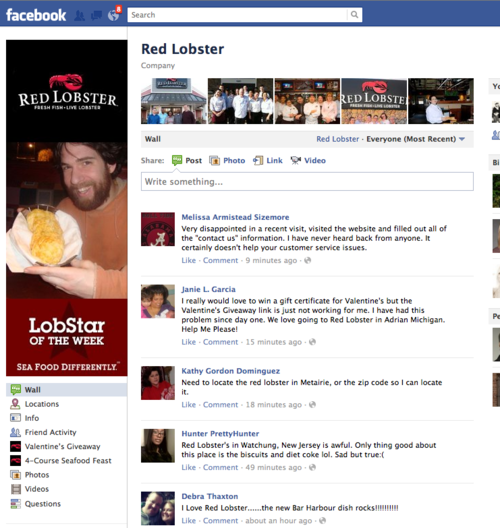
SM contributes to loyalty, and to brand building with content both from the customer and the brand. Today, social media is a stable channel, and a brand needs to be involved in this space. I recall Alex Wippurfurth's book Brand Hijack specifially calling for brands to allow consumers to input into the brand building process, with examples like RedBull. His book certainly preceded the social media explosion - but the idea that people own brands as much as the brands themselves was prescient and 100% accurate.
I don't know which direction social media will take right now, but it's not simply a trend, and continuing top down business comms as usual is just wrong. Social media is real, powerful and has implications for your business. And while we may say or think it's almost come out of nowhere - it hasn't. It's only been amplified through technology. This is the piece that may change - we don't know the how necessarily, but we do know the what - people talk and they talk about your brand.
Think about this - we for years had been in the business of making the brands on which we work buzzworthy, something to be talked about. That was the goal of advertising - we wanted people to talk about our brands. And we know they were - we just didn't the details before the explosion.
Now that they're where we can see them, we need to give the people rights.
What i'm saying is, i'm in support of Wippurfuth's thesis that brands need to formally recognize the consumer's control on their business, on their strategy. Content is and will continue to be uber-important, of course, but the shape of that content really has to include the consumer. It has to be real, authentic, like the Sarah Silverman campaign a few year ago. The results speak for themselves. Like my friend Ben Stiller says, "Do It"
How can we say US econ policy has been good for American?
So, I read The Atlantic article by Adam Davidson about the changing landscape of American manufacturing. Thomas Friedman also commented on the piece.
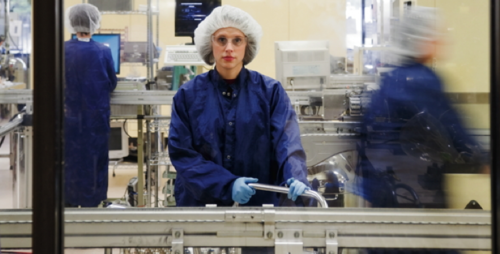
I thought it was going to be longer, but it was fine. Length aside, I thought it was pretty straightforward, and made sense - about how the US is holding on to skilled labor - ie heavy and/or precise machinery, engineering, etc., but outsourcing unskilled labor - ie apparel, toys, and the like. I didn't see anything in the article that was surprising; it was essentially upholding the rule we've been living with as long as I can remember: education takes you farther.
 There was one area of the article I thought was interesting: Standard's engineers examining parts to identify where they could be produced most (cost) effectively. For me - that connected with what I do - but hadn't thought of in that way. I work in advertising, and up until recently had thought of what I do as creative exercise.
There was one area of the article I thought was interesting: Standard's engineers examining parts to identify where they could be produced most (cost) effectively. For me - that connected with what I do - but hadn't thought of in that way. I work in advertising, and up until recently had thought of what I do as creative exercise.
I just never thought of advertising as a business - probably lucky for me. Until now. That piece of the article really just clarified for me 1) that I do in fact work in a factory, 2) I do produce a specialized product, and 3) that managers upstream determine which direction work flows.
I'm fortunate I have the education to work in this 'factory' and produce the product I do. I'm feeling a little more grown up now...
Prescient Super Sad True Love Story - Delivers
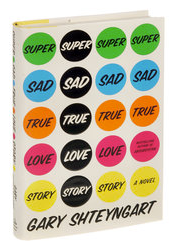 I finished the novel Super Sad True Love Story by Gary Shteyngart. I loved this book. It was just super plain fun to read, which is a major irony running in the book's not-too-distant future setting. The main story, multiple story lines, setting, and characters are more than prescient - they're radically current. The ending is apropot.
I finished the novel Super Sad True Love Story by Gary Shteyngart. I loved this book. It was just super plain fun to read, which is a major irony running in the book's not-too-distant future setting. The main story, multiple story lines, setting, and characters are more than prescient - they're radically current. The ending is apropot.
Thanks to @TedManger for the recommendation.
Yes, Revenge of the Nerds

There's often talk that we need to educate our kids on things like art, and not strictly science and math - and actually if you guys are reading anything about education in the US - it's that we're not teaching them anything - or jack shit. or their not learning anything for a host of reasons - media/technology, kids don't care, parents don't care teachers suck, budget cuts, down the list we go.
Anyway, yesterday's WSJ had a brilliant column from a Vinton G. Cerf (I don't know either but a bionote is below) who's saying we need to promote better our scientists and engineers. Not just our rock stars and jocks. (thought that's funny, and kind of a historical man-meme). Cerf is saying - and maybe it was interesting the column ran on the 50th anniversary of the Yuri Gagharin's flight into space - that all of the toys we play with today are the result of inventions and ingenuity from the engineer people.
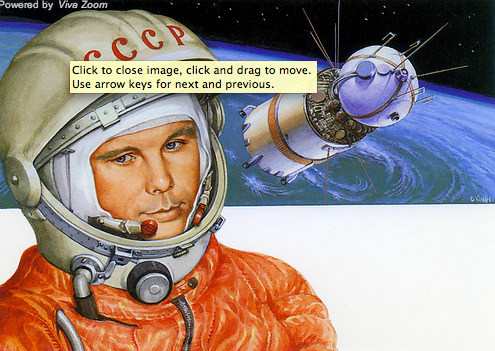
Things like the lithium ion battery which powers your ipad, and is making more energy efficient cars, to things like robotic-powered devices like drones which save (some) people's lives.
Apple is doing this with their promotional video for ipad - it's a 5-minute piece which features the engineers behind the product and they actually sell the usability and fun for the consumer.
I know I went there, but they won the fraternity games, and they got the girls, and they got respect (with some help from the other Lambda chapters). Watch the video, enjoy - and read up!
WSJ bionote on Cerf:
Mr. Cerf, who helped develop the Internet as a pioneer in data networking technology, is the chief Internet evangelist at Google. He is also a fellow at the Institute of Electrical and Electronics Engineers.
Media engagement 2011, looking like media engagement 1985.
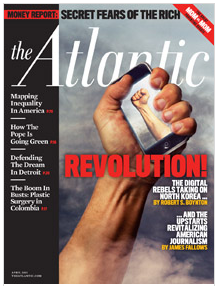 April's issue of the The Atlantic got me thinking about the state of media today, 2011, with a couple of pretty good and substantial pieces, by James Fallows and former FCC Commissioner Newton N. Minow.
April's issue of the The Atlantic got me thinking about the state of media today, 2011, with a couple of pretty good and substantial pieces, by James Fallows and former FCC Commissioner Newton N. Minow.
The Jist: I'm feeling that right now media is very much converging as it's evolving.
The Nut: In the communications business, we talk about engagement every day. The question is - what is engagement? who's definition are we using?
I write this because in the Fallows article Gawker's Nick Denton "concluded that courting commenters (a engaged community) is a dead end. A site has to keep attracting new users—the omnipresent screens were recording the “new uniques” each story brought to the Gawker world—and an in-group of commenters might scare new visitors off. 'People say it’s all about ‘engagement’ and ‘interaction,’ but that’s wrong,' he said. 'New visitors are a better indicator and predictor of future growth.'
To me - this thinking directly lines up with the traditional media - get the eyeballs.
New Media, as is being defined, does not own a fixed definition for engagement, but rather a variable one. Denton seems to have found one that works for him - traffic. It's simple. His means are to provide users - or the audience - what it wants. Give them the content they're looking for. This is old fashioned market forces at work. It's an interesting take on community, and what's old is new again.
See, social media and interactive/digital (whatever you want to call it) live together, yes. Interactive work can be shared, but that sharing can't be forced.
I think this is pretty interesting - and speaks directly to the content. Content is king. Maybe we're learning about this digital/interactive sphere.
2 quick things left :
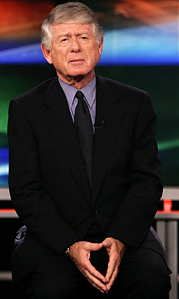
Ted Koppel on CNN
1) the prediction for real or hard news is that it's going to have to be handled at the grassroots level almost, local/volunteer, or philanthropic. Some of it is happening - but who's going to interview the President. There's still a need for serious journalism.
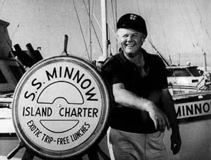
2) Minow is the commissioner who called 'TV a vast wasteland', and is essentially on the same mission, in that however technology is applied to communications, he wants media to be used for public good, like education, health care and public speech. BTW, check the name of the boat Gilligan's Island.
The Whitney over President's Day Weekend
Hit the Witney this past weekend. They were advertising for Edward Hopper exhibition.
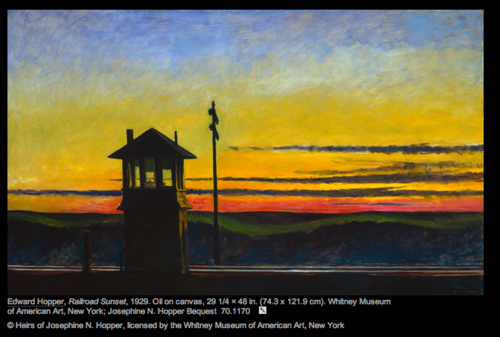
I liked it. He's real, but open, there are shapes and definitions, but he's not confining. he lets the space tell they story. I appreciate that. In the couple of works I've painted, my second hits me in this way. I'm far from a professional painter, so exactitude is not one of my strengths. I'm more into representation. anyhoo. it was good stuff. I like two things in addition to some of the Hopper.
1) River Rouge Plant by Charles Sheeler. This was in the room of other industrial-type works of the period. I'm really loving that era in between the wars. and even the wartime artwork (The Guggenheim had a between wars exhibit a few months back. Striking. Thomas Hart Benton's Poker Night from A Streetcar Named Desire showed at the Whitney, and he also had produced war time work, which I think is so passionate.
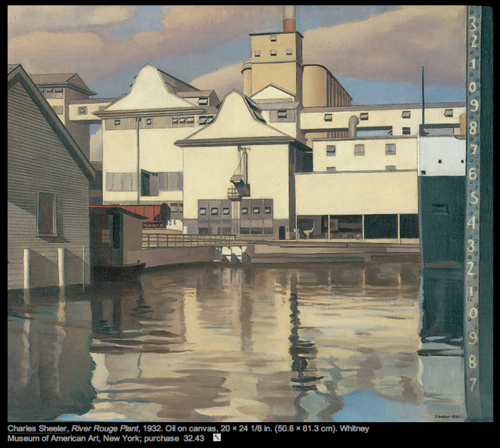
Scheeler called this monument to American Industry and the modern equivalent of the cathedral, "our substitute for religious experience."
2) The other think about the Whitney is obviously it's contemporary work which features jasper johns, andy Warhol, and Matthew Barney among others.
Some thoughts, collections and observations from the 4th floor:
Johns on his 1998 Manet saying to the effect, painting can be conversations with other paintings or with oneself.
Agnes Martin's 1960 Rain: "Art is the concrete representation of our most subtle feelings." not a specific response but that quality of response from people when they leave themselves behind, often experienced in nature - an experience of simple joy....the smile, direct going into a field as you would cross an empty beach to look at the ocean."
The net for me when hitting art is just to feel it. it's lively, energetic, passionate. I'm jealous, but inspired and motivated when i leave. it's exciting.
Axe's Naught2Nice is brilliant creative.
meeting the makers with influx, @cotton
I've been wanting to write about the meet the makers conference I attended earlier this month which was put on by influx insights and Ed Cotton. It was a good exhibition and get together. Ed brought together an eclectic group of doers essentially, from a craft brooklyn bicycle maker Thomas Callahan of Horse Cycles to Behance co-founder and author Scott Belsky to Sarah Rich, of the 48-hour magazine Longshot.
Ed also had in Mark Barden, author of Eat Big Fish. He's a long time name in the business, and it was very grounding for me to see some of the work and new insight gathering techniques Mark had adopted that dovetailed with work I've been comfortable with for a while.

The session also included a 'creating an instant character' exercise run by improv performer Gary Hirsch of On Your Feet - which was fun, and got the group on their feet, collaborating and of course, making. (photos below).
The greatest impact on me was the Sarah Rich's 48-hour magazine (now called Longshot) - developed entirely online, and with submissions, ideas, and understandings also all gathered digitally and through Twitter/social media. This effort was the really the first step in my belief in the power of social media to create something very cool and positive, and not just some game or contest sponsored by a client.
This was a people effort. Which today brings me to step 2: Lady Gaga - and her use of Twitter to raise awareness for the Don't Ask Don't Tell policy and insistence of its repeal - which this past weekend Congress did in fact vote to strike. She didn't do it alone, but using her platform, she helped move this policy forward. That's a huge step for social media. It maybe Twitter is the channel or property of power, as the landscape begins to take shape. Myspace for music, Facebook for social calendar, fun, and pics. Twitter for news and business.

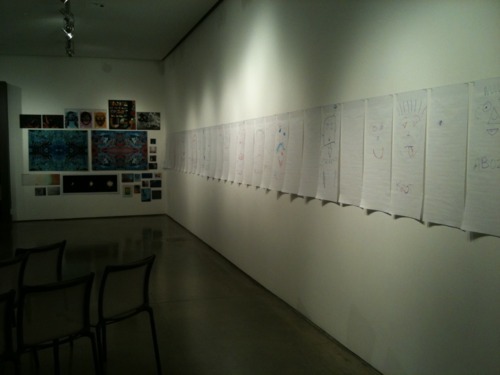
Guggenheim Visit - Chaos and Classicism Exhibition
 Made a field trip to the Guggenheim this weekend to check the Chaos and Classicism exhibition. This was work produced during the 'inter-war' period. it's highly charged, uber-creative (of course), but political. you see emotional energy in the period - from the dawn of the armistice and the rise from the depth of war through the strengthening to the brink - or as the Guggenheim set - the 1936 olympic games.
Made a field trip to the Guggenheim this weekend to check the Chaos and Classicism exhibition. This was work produced during the 'inter-war' period. it's highly charged, uber-creative (of course), but political. you see emotional energy in the period - from the dawn of the armistice and the rise from the depth of war through the strengthening to the brink - or as the Guggenheim set - the 1936 olympic games.
Really enjoyed the work, the energy. I love the guggenheim. I feel connected to the work when i'm there. The site's writeup will do a much better job than me of explaining the details and the artists, but I do say the energy is sharp, and strong. Recommend strongly, if you enjoy art and feeling.
This is Fridel Dehleffs-Edelmann. self-portrait wearing an artist's smock. Germany. 1932.
1 more work from the online exhibit.
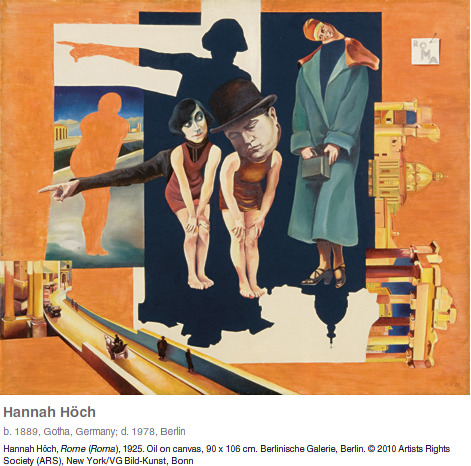
Enjoy, and hope to see you later in the week.
Denise Richards at SMW panel
Had this note on a celeb panel I attended from Social Media Week
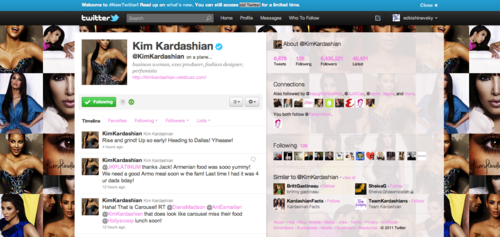
The panel:
Celebrity Spokesperson in The Digital Age, Hosted by Hearst
Hosted at the Art & Culture Hub at Hearst
Event Description:
Gone are the days when a celebrity spokesperson only needed to do a couple of photo shoots and use the product. Today's smart brands are partnering with celebrities who have a direct relationship with their fans via social media channels. This panel will explore how mainstream celebs are using social media to increase their value and how social media all stars are turning themselves into brands.
Speakers:
Moderator: Kate White, Editor-in-Chief, Cosmopolitan
- Alisa Leonard, Director of Experience Planning, iCrossing, @alisamleo
- Rob Shuter, Publicist/ Blogger, PopEater, @NaughtyNiceRob
- Denise Richards, Actress
- Natalie Lent, Director of Strategy for ID, @natalielent
- Bryanboy, Fashion Blogger bryanboy.com
Before I pickup my draft, I though it was fun, more than anything. some instructional - in the sense that celebrities are using social media to engage directly with the public. but also in that celebrities are experimenting in the space. and that celebrities are having fun in social media. some are great at it like @KimKardashian - using twitter to stay on top of her reputation, quelch rumours about her family, etc.
i love lady gaga's mission for the DADT - which now challenges Malcolm Gladwell's blast against social media.
I'm not saying Twitter is behind the revolution in Egypt, but i do think of it as a power channel - information, education, advocacy, policy-influence. Yes.
Back to celebs, gossip columnist @NaughtyNiceRob, said sourcing isn't a big deal anymore because celebs come out on their and broadcast.
Below are the high points - there's also a great example of Twitter/Foursquare use by Pee Wee Herman to regenerate interest - great idea.

There was one other thing - that I think we as a culture/society need to figure out. That's the piece where education doesn't matter - like the fashion blogger with no actual experience or training. I have a feeling this is dangerous. as long as we digest @BryanBoy for fun, that's fine. when it gets more impactful, then we need to reassess.
High level points
The panel discussed celebrity involvement with social media.
Twitter is the hot button, probably rightfully so (my example is Lady Gaga – DADT, and Harry Reid)
EG: Power of Kim Kardashian to use her following
- for intelligence (as a giant focus group)
- to position herself and her family – as in quickly addressing any rumours,
- to promote her products
Celebrities and SM
Direct engagement with the audience/consumer – it’s exciting for the consumer to ‘interact’ with the celebrity, it gives them the idea they’re ‘co-creating’ and inputting into the celebrities activities.
Celebrities can
- endorse products
- get closer to their fans, maintain, build or re-build a relationship with their fans; (see PeeWee Herman case below which was a great example of using 2 social media vehicles – Twitter and Foursquare – for promotion and inclusion
- Raise awareness for charity, political, social concerns
Interesting program PeeWee’s Parade
PR strategist Natalie Lent described a very successful event program her group designed for PeeWee Herman featuring both Twitter and Foursqaure to rebuild awareness for the character. Lent admitted she did not know PeeWee from his playhouse days. The group devised a PeeWee Parade around New York and had him tweet and check in to places he went, like Katz’s deli, the Highline canal, his show on Broadway, and finished with a night of bowling with PeeWee at Bowlmor that only people who collected badges along the parade route, and went along the journey, could get into. I thought this was pretty cool. (My) NYTimes showed up along the route because they were following PW, not because they received a release. Links (the video is great):
BryanBoy consumer voice
The other point that I take from this is the BryanBoy blogger.
He’s become an influential voice in the fashion community with (I believe) over 120K monthly visitors/viewers. Marc Jacobs named a $5,000 bag after him.
Interesting because he admits he has no fashion background, training, skills, etc. to actually criticize the industry. He reports strictly on what he sees.
- True voice of the consumer, and the industry is listening – it’s amazing really – and in this sense – it’s great that industry is listening to its consumers. Pure, unadulterated.
- At the other end of the spectrum to me it’s like the analogy of watching a football game on tv and the commentator is your neighbor instead of Troy Aikmen. Sure your neighbor played in the backyard, and BryanBoy wears clothes. So they can both talk about it, yes, but with what level of knowledge or intelligence? How much of this is pandering?
Some SM rules, bits – which I think we pretty much know:
Greatest value: research – intelligence, direct engagement, Be: Transparent and Authentic Don’t be: Boring, Read: mashable, per Icrossing’s Leonard
Additional: It’s ok to take a moment to think (pause) before you broadcast
“you don't need sources anymore because the celebs themselves are saying what's up,” per columnist Shuter
check out these Facebook, Twitter social demographics
foursquare #fail
 This is a #foursquare #fail. check the exclamation points!! I like four square, but programmers, add some thinking to ur work.
This is a #foursquare #fail. check the exclamation points!! I like four square, but programmers, add some thinking to ur work.
Median Household Income by county, US Census. Dec. 2010

Charles Murray's Coming Apart is a passionate call for America
Finally finished the Charles Murray book Coming Apart. Super interesting thesis - Essentially two major points:
1) The upper class has a responsibility to get back involved in the moral foundation of this country. ( I don't disagree). And I think there is an over PC space that we've gone to that isn't always making sense anymore. We have to be real and true, and call things out. Like Chris Rock when he said 'you're supposed to take care of your kids.' Kids are better with two parents (better if they're the biological parents).
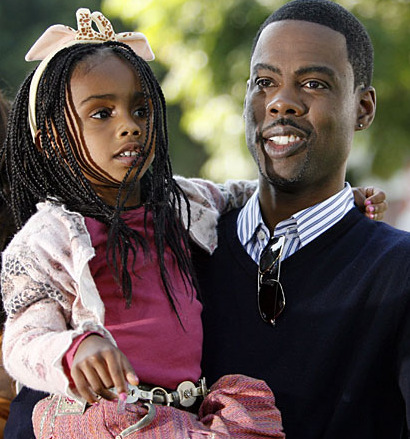
Essentially, Murray is saying it's time we come back to the notion of personal, as well as community responsibility. The point here is that it's not just what's right, but that things like work and marriage make people happier - they give people a sense of self-worth, self-respect - things that the welfare states of Europe cannot give people. I think he's right here. There are times for welfare, surely, and I can attest, but personal uplift is beautiful, strong - and it is the American story - or American Project (as Murray calls it). His thesis is passionate, and what is clear is that he loves America - and his purpose with the book is to raise a red flag and start the conversation for rebuilding our national fabric.
Interesting that he (and other socio works I've read) quote de Toqueville as support for a track record of strength. And that gets into why the US is a great spirit of a country - that in these tough times, we as a people do come together, and find a way to straighten ourselves out. And I believe there really is a magic spirit about this country.
Like Churchill said, Americans can always be counted on to do the right thing...after they have exhausted all other possibilities.
Let's do it guys!!
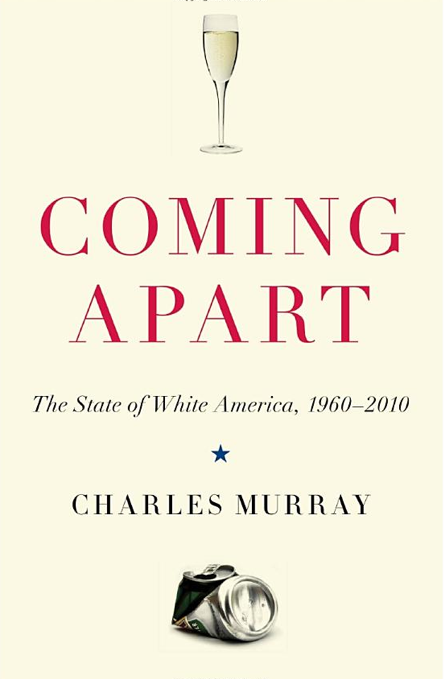
Letter to the Editor - School Busing Works; Enhances Cultural Experience
Ultimate Mashup: David Brooks sampling Too $hort via: 'The Creative Monopoly'; like a smart Just Do It
Not going to see this too often - David Brooks linking with the old school rapper Too$hort. But it makes sense to me, follow:
Brooks' column kills it for me. My interpretation of what Brooks is saying is to be smart, be intelligent, like the rapper in the tune The Ghetto - "be intelligent when you put them in check."
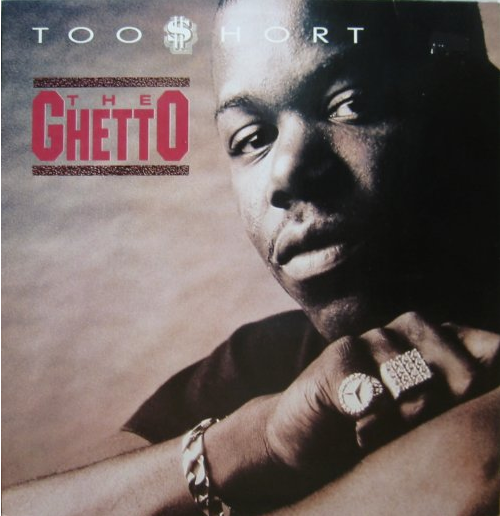
Writes Brooks: "Think about the traits that creative people possess. Creative people don’t follow the crowds; they seek out the blank spots on the map.
 Creative people wander through faraway and forgotten traditions and then integrate marginal perspectives back to the mainstream. Instead of being fastest around the tracks everybody knows, creative people move adaptively through wildernesses nobody knows."
Creative people wander through faraway and forgotten traditions and then integrate marginal perspectives back to the mainstream. Instead of being fastest around the tracks everybody knows, creative people move adaptively through wildernesses nobody knows."
For me right now - this really made my day.


